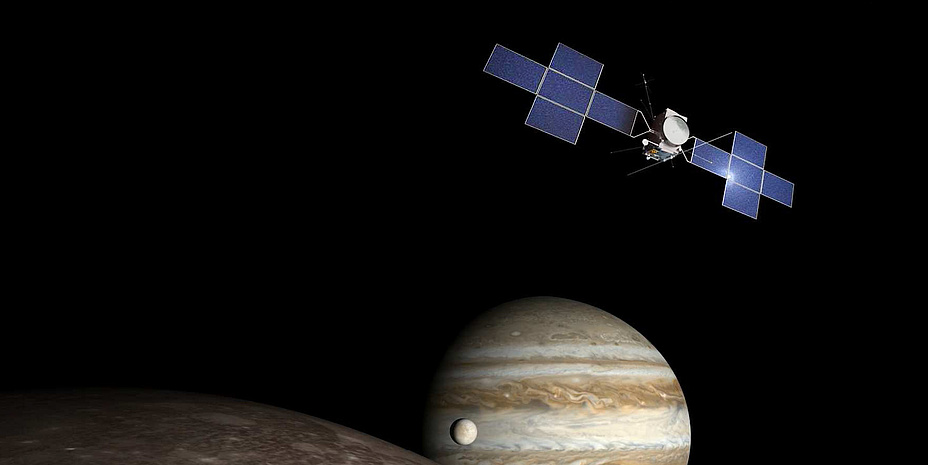JUICE Magnetometer Successfully Commissioned in Space

The European Space Agency’s JUpiter ICy moons Explorer (JUICE) spacecraft has achieved another milestone. It started its eight-year journey to the Jupiter system on 14 April 2023 to explore the largest planet in our solar system and its icy moons – Ganymede, Callisto and Europa – which may offer the essential requisites for life. Four weeks after the launch, the three-sensor magnetometer J-MAG, in which the Space Research Institute (IWF) of the Austrian Academy of Sciences (ÖAW) and Graz University of Technology (TU Graz) are also involved, was successfully put into operation.
Green light for magnetic field measurement on the way to Jupiter
The J-MAG magnetometer, led by Michele Dougherty of Imperial College London, consists of three sensors that will look at the magnetic field of Jupiter and its moons. However, there is still a long way to go before measurements can begin. During an initial detailed commissioning, all three sensors proved to be perfectly functional. This was also the first time the Austrian quantum interference sensor – a precise but complex technology – went into action outside Earth orbit.
J-MAG will be crucial for the JUICE mission to describe the oceans suspected to lie beneath the outer ice crusts of Jupiter’s moons Ganymede, Callisto and Europa, and to determine whether they could contain life.
Although JUICE will take about eight years to reach the Jupiter system, the instrument’s early test success is an important milestone for mission feasibility. “We are very relieved that all three sensors have survived the launch well and are working excellently. It’s so exciting to see the trio working perfectly together and measuring the interplanetary magnetic field correctly,” says a very glad Michele Dougherty.
New sensor technology from Austria
Of the three J-MAG sensors, one was built at Imperial College, one at the Technical University of Braunschweig and one at the ÖAW Space Institute in collaboration with TU Graz.
The instruments from Imperial College and TU Braunschweig are fluxgate sensors that can measure the direction and strength of magnetic fields. They are called outboard (MAGOBS) or inboard (MAGIBS) sensors, which are mounted at three-metre intervals on a 10.6-metre boom to isolate the sensors from the influence of the spacecraft.
Fluxgate sensors must be calibrated regularly during flight. The magnetic environment around Ganymede is so complicated and changes so quickly that conventional calibration methods do not work. This important task is carried out by the third sensor – MAGSCA, a sensitive and accurate quantum sensor built in Graz and located at the tip of the boom.
MAGSCA measures the size of the magnetic field using the Zeeman effect, which splits the energy levels of the electrons of rubidium atoms in relation to the size of the magnetic field. This measurement is free of calibration errors because the effect is based on fundamental physical constants. “The quantum effect is generated by specifically modulated laser light interacting with rubidium atoms in the glass cell of the MAGSCA sensor,” explains Roland Lammegger, project manager at the Institute of Experimental Physics at TU Graz and inventor of this measurement method.
Space Research Institute group leader Werner Magnes, under whose leadership MAGSCA was realised, followed the commissioning live with his team at the ESA Control Centre in Darmstadt: “Developing this new technology for the Jupiter mission was a major challenge for the entire J-MAG team, which received excellent support from ESA and the satellite manufacturer Airbus. We are proud and happy that the Graz sensor now works perfectly in space.”
Successful measurements
The very first detection of the quantum interference signal for magnetic field measurement with MAGSCA was provided by the JUICE space probe from a distance of 5 million kilometres from Earth.
By simultaneously measuring the fluctuations of the interplanetary magnetic field, it was possible to prove that all three J-MAG sensors are providing perfect results.
Future outlook
J-MAG is the first instrument to have successfully completed the commissioning phase. Now all the remaining scientific instruments on board JUICE will be tested one after the other. The magnetometer remains switched on during this time to check to what extent the other instruments influence the magnetic field measurement. After that, there will be regular instrument checks every few months.
The next big highlight of the mission will be an Earth-moon fly-by by JUICE in September 2024.
Funding
The development and construction of MAGSCA was made possible by the Aerospace Agency (ALR) of the Austrian Research Promotion Agency (FFG) through ESA’s PRODEX elective programme and the national space programme ASAP. The ESA and ASAP funds were provided by the Federal Ministry for Climate Protection, Environment, Energy, Mobility, Innovation and Technology. The complementary financing of the magnetometer was made possible by the Austrian Academy of Sciences (ÖAW) and TU Graz, whose responsible ministry is the Federal Ministry of Education, Science and Research.
Kontakt
Werner MAGNES
Dipl.-Ing. Dr.techn.
Austrian Academy of Sciences
Mobile: +43 699 10390604
werner.magnes@oeaw.ac.at
TU Graz:
Roland LAMMEGGER
Dipl.-Ing. Dr.techn.
TU Graz | Institute of Experimental Physics
Mobile: +43 664 73810762
roland.lammegger@tugraz.at




